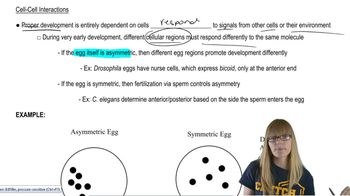If a man and a woman are each heterozygous carriers of a mutation causing a disease on the RUSP list, what do you think are the three or four most important factors they should consider in their decision making about having children?
Describe the role of the following structures or proteins in cell division:
cohesin protein
 Verified step by step guidance
Verified step by step guidance
Verified video answer for a similar problem:
Key Concepts
Cohesin Protein

Cell Division

Chromatid Separation

Suppose a man and a woman are each heterozygous carriers of a mutation causing a fatal hereditary disease not on the RUSP list. Prenatal genetic testing can identify the genotype of a fetus with regard to this disease and can identify fetuses with the disease. What do you think are the three or four most important factors this couple should consider in their decision making about having children?
How many Barr bodies are found in a normal human female nucleus? In a normal male nucleus?
Describe the role of the following structures or proteins in cell division:
kinetochores
Describe the role of the following structures or proteins in cell division:
synaptonemal complex
Describe the role of the following structures or proteins in cell division:
microtubules
